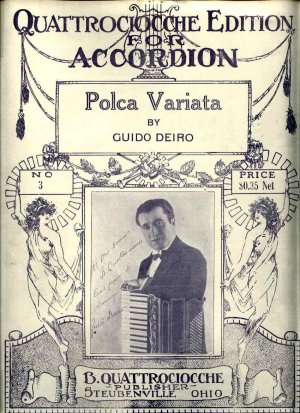|
Guido Deiro's compositions for accordion were, with few exceptions (see Radio Folio), published in sheet music format which measured nine inches in width and twelve inches in height. The cover pages of the early Quattrociocche accordion editions were ornate and printed with colored ink in various shades of purple, green, red, etc. Guido's publicity photo appeared on the cover, signed with the following Italian inscription -- in the dialect of the Piedmonte region -- penned in his own handwriting: Al Mio Amico B. QuattrocioccheIn English: To my friend B. QuattrocioccheThe music for the left hand was notated in treble clef in the early editions, because, at that time, most accordionists could simply not read the bass clef. (The first printed accordion music in which the left hand was notated in bass clef was probably The Accordion Method Book by Anthony Galla-Rini [1931].) The chord buttons were written as single notes (as in modern American editions) with the numerals 1, 2 and 3 printed above to indicate major, minor and seventh chords.
The title of Deiro's first published composition by Quattrociocche (1916) was spelled Polca Variata on the cover and Polka Variata on the first inside page. |

Early Quattrociocche Edition (1916)
|